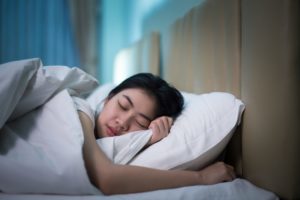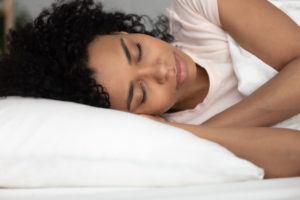When you buy through our links, we may earn a commission. Products or services may be offered by an affiliated entity. Learn more.
Stages of Sleep: What Happens in a Sleep Cycle
- Three non-rapid eye movement stages and one rapid eye movement stage make up one sleep cycle.
- A person will typically go through four to six sleep cycles per night, although the duration of each stage may vary.
- The sleep stages allow the brain to recuperate from the day and support multiple functions.
- Improved sleep hygiene can encourage healthy transitions through the sleep stages.
When thinking about getting the sleep you need, it is normal to focus on how many hours of sleep you get. While sleep duration is undoubtedly important, it is not the only part of the equation.
It is also critical to think about sleep quality and whether the time spent sleeping is actually restorative. Progressing smoothly multiple times through the sleep cycle, composed of four separate sleep stages, is a vital part of getting high-quality rest.
Each sleep stage plays a part in allowing the mind and body to wake up refreshed. Understanding the sleep cycle also helps explain how certain sleep disorders, including insomnia and obstructive sleep apnea, can impact a person’s sleep and health.
What Is the Sleep Cycle?
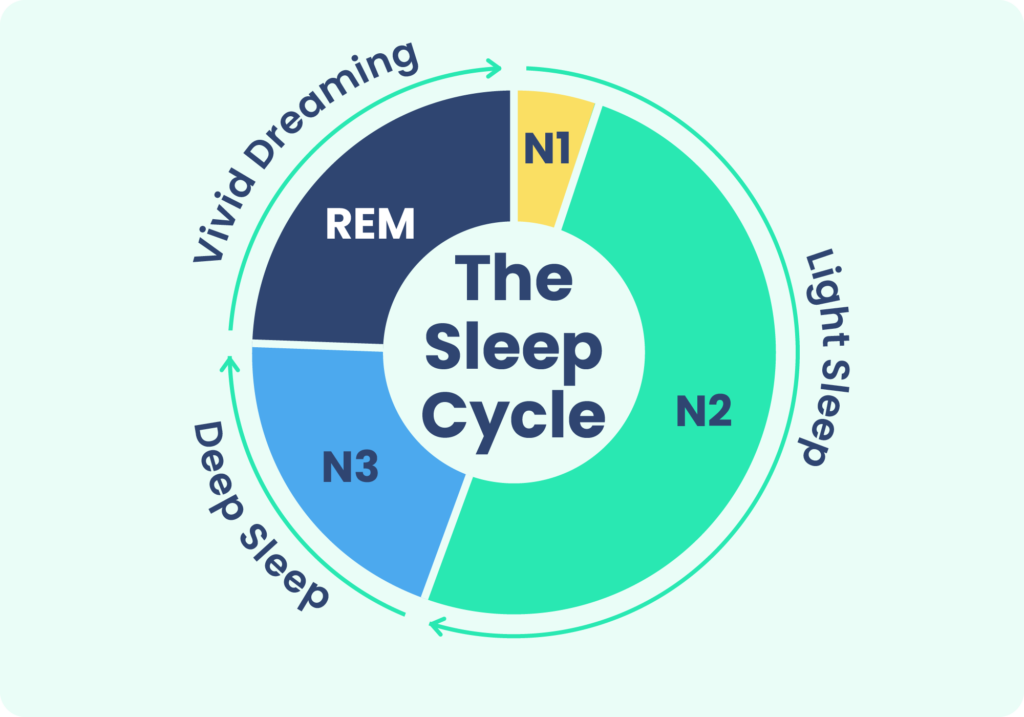
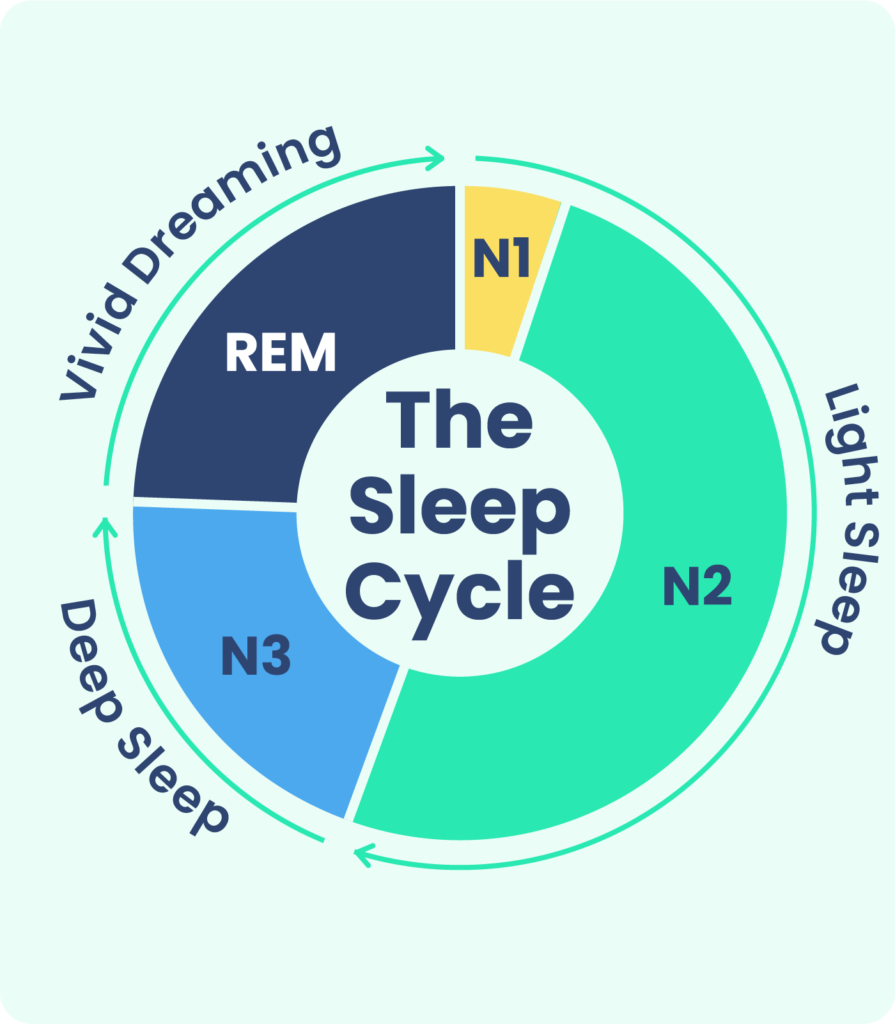
Sleep is not uniform. Instead, over the course of the night, your total sleep is made up of several rounds of the sleep cycle, which is composed of four individual stages. In a typical night, a person goes through four to six sleep cycles . Not all sleep cycles are the same length, but on average they last about 90 minutes each.

Are All Sleep Cycles the Same?
It is normal for sleep cycles to change as you progress through your nightly sleep. The first sleep cycle is often the shortest, ranging from 70 to 100 minutes, while later cycles tend to fall between 90 and 120 minutes. In addition, the composition of each cycle – how much time is spent in each sleep stage – changes as the night goes along.
Sleep cycles can vary from person to person and from night to night based on a wide range of factors such as age, recent sleep patterns, and alcohol consumption.
What Are the Sleep Stages in a Normal Sleep Cycle?
There are four sleep stages, including one for rapid eye movement (REM) sleep and three that form non-REM (NREM) sleep. These stages are determined based on an analysis of brain activity during sleep, which shows distinct patterns that characterize each stage.
| Sleep Stages | Type of Sleep | Other Names | Normal Length |
|---|---|---|---|
| Stage 1 | NREM | N1 | 1-7 minutes |
| Stage 2 | NREM | N2 | 10-25 minutes |
| Stage 3 | NREM | N3, slow-wave sleep (SWS), delta sleep, deep sleep | 20-40 minutes |
| Stage 4 | REM | REM Sleep | 10-60 minutes |
The breakdown of a person’s sleep into various cycles and stages is commonly referred to as sleep architecture. If someone undergoes a sleep study, their sleep architecture can be represented visually in a hypnogram, or graph.

NREM Sleep Patterns
NREM sleep is composed of three different stages. The higher the stage of NREM sleep, the harder it is to wake a person up.
Stage 1
Stage 1, also called N1, is essentially when a person first falls asleep. This stage normally lasts just one to seven minutes.
During N1 sleep, the body has not fully relaxed, though the body and brain activities start to slow with periods of brief movements. There are light changes in brain activity associated with falling asleep in this stage.
It is easy to wake someone up during this sleep stage, but if a person is not disturbed, they can move quickly into stage 2. As the night unfolds, an uninterrupted sleeper may not spend much more time in stage 1 as they move through further sleep cycles.
Stage 2
During stage 2, or N2, the body enters a more subdued state including a drop in temperature, relaxed muscles, and slowed breathing and heart rate. At the same time, brain waves show a new pattern and eye movement stops. On the whole, brain activity slows, but there are short bursts of activity that actually help resist being woken up by external stimuli.
Stage 2 sleep can last for 10 to 25 minutes during the first sleep cycle, and each N2 stage can become longer during the night. Collectively, a person typically spends about half their sleep time in N2 sleep.
Stage 3
Stage 3 sleep is also known as N3 or deep sleep, and it is harder to wake someone up if they are in this phase. Muscle tone, pulse, and breathing rate decrease in N3 sleep as the body relaxes even further.
The brain activity during this period has an identifiable pattern of what are known as delta waves. For this reason, stage 3 may also be called delta sleep or slow-wave sleep (SWS).
Experts believe that this stage is critical to restorative sleep, allowing for bodily recovery and growth. It may also bolster the immune system and other key bodily processes. Even though brain activity is reduced, there is evidence that deep sleep contributes to insightful thinking , creativity , and memory.
You spend the most time in deep sleep during the first half of the night. During the early sleep cycles, N3 stages commonly last for 20 to 40 minutes. As you continue sleeping, these stages get shorter, and more time gets spent in REM sleep instead.
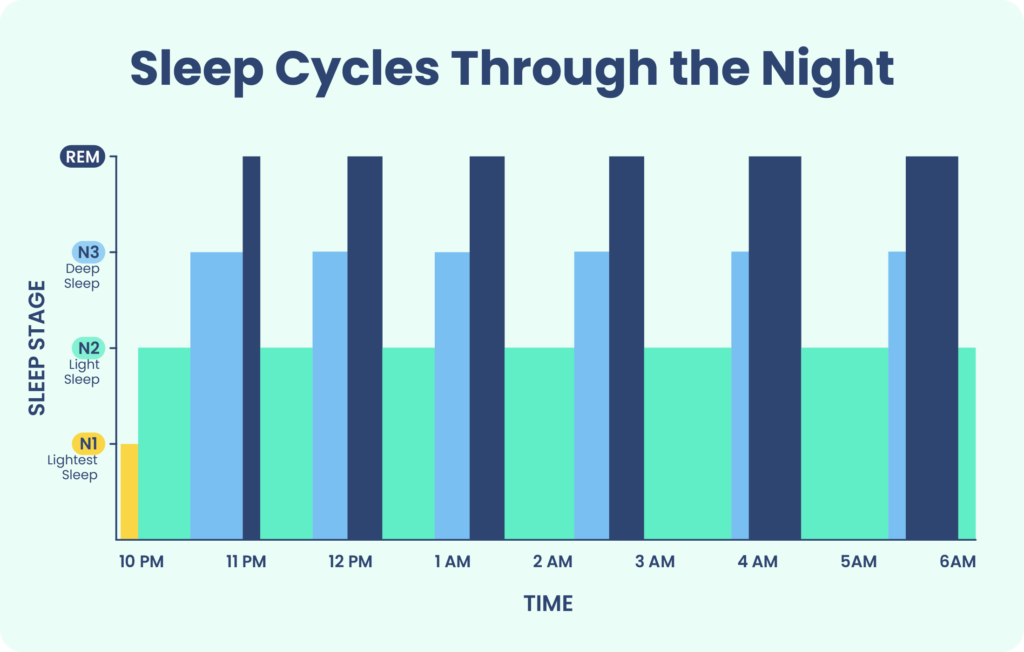
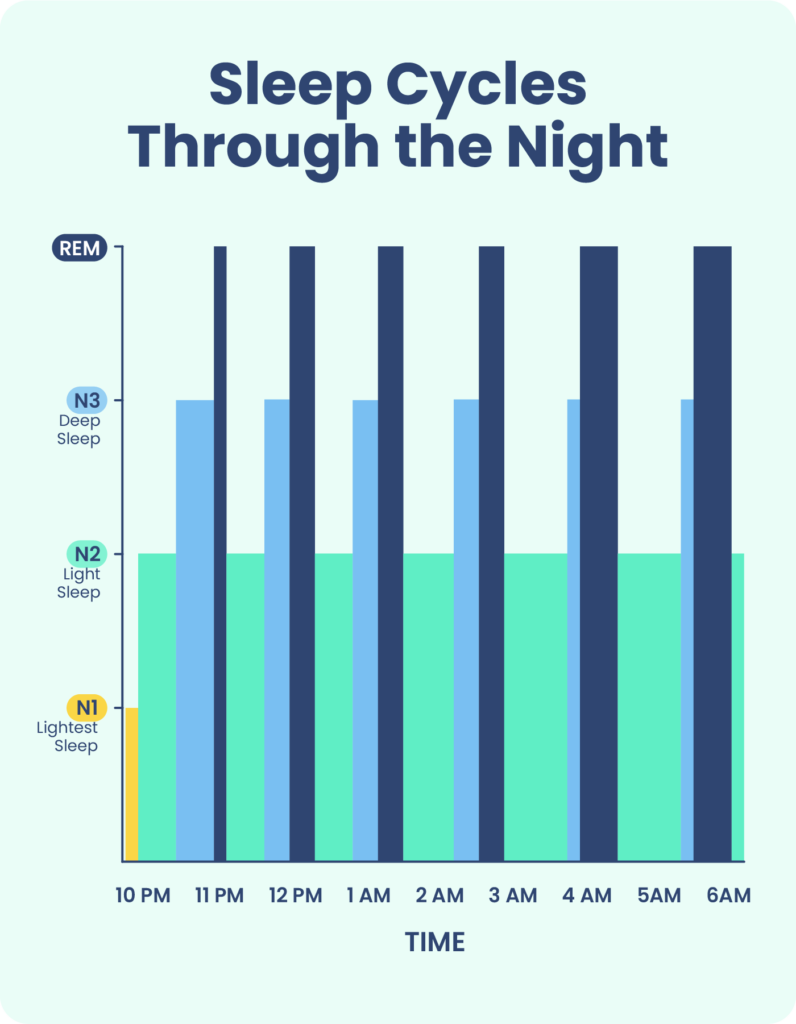
REM Sleep Patterns: What Is REM Sleep?
During REM sleep, brain activity picks up, nearing levels seen when you are awake. At the same time, the body experiences atonia, which is a temporary paralysis of the muscles, with two exceptions: the eyes and the muscles that control breathing. Even though the eyes are closed, they can be seen moving quickly, which is how this stage gets its name.
REM sleep is believed to be essential to cognitive functions like memory , learning, and creativity . REM sleep is known for the most vivid dreams, which is explained by the significant uptick in brain activity. Dreams can occur in any sleep stage, but they are less common and intense in the NREM periods.
Under normal circumstances, you do not enter a REM sleep stage until you have been asleep for about 90 minutes. As the night goes on, REM stages get longer, especially in the second half of the night. While the first REM stage may last only a few minutes, later stages can last for around an hour. In total, REM stages make up around 25% of sleep in adults.
Why Do the Sleep Stages Matter?
Sleep stages are important because they allow the brain and body to recuperate and develop. Failure to obtain enough of both deep sleep and REM sleep may explain some of the profound consequences of insufficient sleep on thinking , emotions, and physical health. Sleepers who are frequently awoken during earlier stages, such as people with sleep apnea, may struggle to properly cycle into these deeper sleep stages. People with insomnia may not get enough total sleep to accumulate the needed time in each stage.
What Affects Sleep Stages?
While there is a typical pattern for sleep stages, there can be substantial individual variation based on a number of factors .
- Age: Time in each stage changes dramatically over a person’s life. Newborns spend far more time in REM sleep and may enter a REM stage as soon as they fall asleep. As they get older, their sleep becomes similar to that of adults. Older adults tend to spend less time in REM sleep.
- Recent sleep patterns: If a person gets irregular or insufficient sleep over a period of days or more, it can cause an abnormal sleep cycle.
- Alcohol: Alcohol and some other drugs can alter sleep architecture. For example, alcohol decreases REM sleep early in the night, but as the alcohol wears off, there is a REM sleep rebound, with prolonged REM stages.
- Sleep disorders: Sleep apnea, restless legs syndrome (RLS), and other conditions that cause multiple awakenings may interrupt a healthy sleep cycle.
How Can You Have a Healthier Sleep Cycle?
While you do not have full control of your sleep cycle, you can take steps to improve your chances of having a healthy progression through each sleep stage.
A key step is to focus on improving your sleep hygiene, which refers to your sleep environment and sleep-related habits. Achieving a more consistent sleep schedule, getting natural daylight exposure, avoiding alcohol before bedtime, and eliminating noise and light disruptions can help you get uninterrupted sleep and promote proper alignment of your circadian rhythm. Your mattress, pillows, and sheets can also contribute to how comfortable your sleep environment is.
If you find that you have excessive daytime sleepiness or otherwise suspect that you might have a sleep disorder like sleep apnea, it is important to talk with a doctor who can most appropriately guide your care. Addressing underlying issues may pave the way for more complete and restorative sleep cycles.

Still have questions? Ask our community!
Join our Sleep Care Community — a trusted hub of sleep health professionals, product specialists, and people just like you. Whether you need expert sleep advice for your insomnia or you’re searching for the perfect mattress, we’ve got you covered. Get personalized guidance from the experts who know sleep best.
References
8 Sources
-
Patel, A.K., Reddy, V., & Araujo, J.F. (2022, September 7). Physiology, sleep stages. In StatPearls. StatPearls Publishing., Retrieved December 6, 2022, from
https://www.ncbi.nlm.nih.gov/books/NBK526132/ -
Schönauer, M., & Pöhlchen, D. (2018). Sleep spindles. Current Biology, 28(19), R1129–R1130.
https://pubmed.ncbi.nlm.nih.gov/30300592/ -
Yordanova, J., Kolev, V., Wagner, U., & Verleger, R. (2010). Differential associations of early- and late-night sleep with functional brain states promoting insight to abstract task regularity. PloS one, 5(2), e9442.
https://pubmed.ncbi.nlm.nih.gov/20195475/ -
Drago, V., Foster, P. S., Heilman, K. M., Aricò, D., Williamson, J., Montagna, P., & Ferri, R. (2011). Cyclic alternating pattern in sleep and its relationship to creativity. Sleep medicine, 12(4), 361–366.
https://linkinghub.elsevier.com/retrieve/pii/S1389945711000578 -
Kirsch, D. (2021, November 8). Stages and architecture of normal sleep. In A.F. Eichler (Ed.). UpToDate., Retrieved December 6, 2022, from
https://www.uptodate.com/contents/stages-and-architecture-of-normal-sleep -
Cai, D. J., Mednick, S. A., Harrison, E. M., Kanady, J. C., & Mednick, S. C. (2009). REM, not incubation, improves creativity by priming associative networks. Proceedings of the National Academy of Sciences of the United States of America, 106(25), 10130–10134.
https://pubmed.ncbi.nlm.nih.gov/19506253/ -
Maquet P. (2000). Sleep on it!. Nature neuroscience, 3(12), 1235–1236.
https://pubmed.ncbi.nlm.nih.gov/11100139/ -
Yetton, B. D., McDevitt, E. A., Cellini, N., Shelton, C., & Mednick, S. C. (2018). Quantifying sleep architecture dynamics and individual differences using big data and Bayesian networks. PloS one, 13(4), e0194604.
https://pubmed.ncbi.nlm.nih.gov/29641599/



